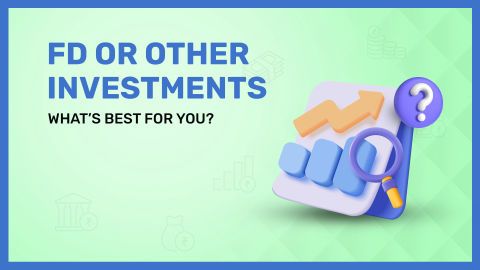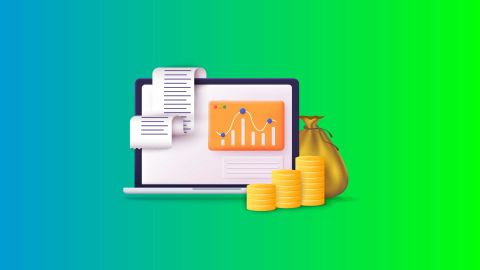When you're planning to invest your hard-earned money, it's natural to want some kind of safety check. That’s where CRISIL ratings come in. Introduced in 1987, CRISIL (Credit Rating Information Services of India Limited) was India’s first credit rating agency. It plays a crucial role in assessing the creditworthiness of companies, mutual funds, and other financial instruments.
Whether you’re an investor, a bank, or a financial regulator, these ratings offer valuable insights into how risky or stable an investment might be. In simple terms, a CRISIL rating can help you invest smarter and with more confidence. A CRISIL rating gives you a ready-made lens to evaluate credit-based mutual fund options, helping you avoid missteps while investing. Compare Mutual Fund Options Now!
Let’s unpack what CRISIL ratings really mean and how they can guide your financial decisions.
What is the CRISIL rating?
CRISIL ratings are essentially a professional opinion on the likelihood of a company or financial instrument defaulting on its obligations. In other words, they help answer the big question how safe is your money?
These ratings are issued after a thorough analysis of a company’s financial position, debt levels, market conditions, and even management quality. A high rating, like AAA, indicates a strong track record and very low risk of default. On the other hand, a rating like D signals that the entity is already in default or very close to it.
CRISIL doesn't just assign a letter grade; it delivers a complete picture of risk, reliability, and financial health. And this isn’t just useful for equity investors—lenders, debt investors, and even mutual fund buyers refer to these ratings before putting in their money. Using CRISIL-rated mutual funds can help reduce your exposure to risk while aligning investments with your long-term goals. Explore Top-Performing Mutual Funds!
What is the CRISIL full form?
CRISIL stands for Credit Rating Information Services of India Limited. It’s more than just a rating agency—it’s a key part of India's financial ecosystem. Established in 1987 and now a subsidiary of S&P Global, CRISIL offers credible, independent evaluations of the financial strength of companies and governments.
But what really sets CRISIL apart is its detailed methodology. It doesn't just look at surface-level numbers. Instead, it analyses everything from cash flows and debt levels to how capable the management team is. This gives investors a well-rounded view of an entity’s ability to meet its financial obligations.
That’s why CRISIL ratings are widely trusted by retail and institutional investors alike. They serve as a benchmark that simplifies complex financial data into a single score that’s easy to interpret, helping you gauge risk at a glance.
How does the CRISIL rating help in making investment decisions?
Think of CRISIL ratings as a cheat sheet that gives you an edge while evaluating investment options. They help you compare how reliable different companies or financial instruments are—so you can align your choices with your risk appetite.
For example, a company with a CRISIL AAA rating is generally considered safer than one rated BB. So, if you're a conservative investor, you’d probably gravitate towards higher-rated options. On the other hand, if you're willing to take a bit more risk for potentially higher returns, you might explore mid-tier ratings.
CRISIL ratings also apply beyond companies—they cover bonds, debentures, and even mutual funds. In fact, many companies actively display their CRISIL ratings to build investor trust. Even banks use these ratings to decide loan terms and lending limits.
And because CRISIL updates its ratings periodically, you always have access to the latest assessment before locking in your decision. This adds an extra layer of transparency and makes it easier to spot red flags or find strong performers in a crowded market. If you're planning to build a low-risk investment portfolio, CRISIL ratings offer a reliable framework to assess mutual fund schemes before you commit. Compare Mutual Fund Options Now!
How are CRISIL ratings assigned?
CRISIL doesn’t hand out ratings on a whim—it follows a meticulous process designed to ensure objectivity, consistency, and transparency. It starts with a detailed information request from the company or entity that wants to be rated. This includes everything from audited financials to business plans, industry outlook, legal liabilities, and debt repayment schedules.
Then comes a deep-dive analysis by a rating committee, made up of financial experts. They evaluate various aspects of the entity—its financial strength, management quality, business environment, past repayment history, and projected performance.
Importantly, CRISIL doesn’t stop at just giving a rating. It monitors and revises ratings as conditions change—like a company’s earnings slipping, or a new loan being taken on. This ongoing evaluation ensures that the ratings reflect the most current and realistic picture of risk.
CRISIL rating scale and what it means
The CRISIL rating scale is designed to be intuitive, helping both retail and institutional investors judge how risky or safe a financial instrument is. Here's a simple breakdown:
AAA: Highest safety; the entity has a strong ability to repay debts on time.
AA, A: High to adequate safety, with slightly higher risk compared to AAA.
BBB: Moderate safety; repayment capacity exists but may be affected by economic shifts.
BB, B, C: These indicate increasing risk, with C being the most vulnerable before default.
D: Default; the company has failed to meet its obligations.
Apart from long-term ratings, CRISIL also provides short-term ratings, especially for instruments like commercial paper or short-term loans. These range from A1 (highest) to D (default), with intermediate grades in between.
This grading scale is more than just letters—it’s a guide that helps you match your investment choices to your risk comfort. If you're planning to invest in debt instruments, a high CRISIL rating can signal reliability, while a low one should raise caution flags.
How can investors use CRISIL ratings?
As an investor, your goal is to grow your wealth without unnecessary surprises. CRISIL ratings are a valuable tool in achieving that.
If you’re evaluating corporate bonds, FDs, or debentures, CRISIL ratings give you a snapshot of how likely the company is to repay. This can help you pick safer instruments, especially if you're aiming for capital preservation.
For mutual fund investors, CRISIL provides rankings and ratings based on fund performance, risk-adjusted returns, and consistency. These help you narrow down your options without digging through hundreds of schemes.
Even if you’re just comparing fixed deposits from different NBFCs or corporates, CRISIL ratings serve as a quick filter. A high rating like FAAA or FAA+ indicates that the company offering the FD is reliable and financially sound.
Are CRISIL ratings reliable?
CRISIL ratings are generally considered highly reliable within India’s financial ecosystem. They are used not just by individual investors, but also by banks, regulators, mutual funds, and large institutions to evaluate credit risk. That’s because CRISIL follows a structured and transparent methodology, backed by data and reviewed by independent committees.
But it’s important to remember that a credit rating is not a guarantee. It reflects the rating agency’s current opinion on the borrower’s ability to repay—based on the data and conditions available at the time of assessment. Any significant change in the company's finances, industry trends, or regulatory environment can prompt a rating revision.
So, while you can trust CRISIL ratings as a strong indicator, it’s always good to look beyond the rating too check fundamentals, management intent, and sector performance before making major investment decisions.
Limitations of CRISIL ratings
CRISIL ratings are helpful—but not foolproof. One major limitation is that they are only as good as the data provided. If a company hides material information or presents an overly optimistic picture, the rating may not fully reflect the real risk.
Also, ratings are not forward-looking guarantees. They may not capture sudden shifts—like geopolitical events, fraud, management changes, or economic shocks—that can impact repayment capacity after the rating has been issued.
For retail investors, another limitation is interpretation. The ratings may seem complex or hard to decode without background knowledge. And while CRISIL updates its ratings, there can be a lag between reality and the next review cycle.
In short, CRISIL ratings are a valuable tool, but they’re best used in combination with your own due diligence and financial advisor guidance.
How are CRISIL ratings different from other agencies?
In India, CRISIL is one of several credit rating agencies, but it holds a leading position in market credibility and coverage. What sets CRISIL apart is its extensive analytical capabilities, wide sector reach, and consistent rating processes. It also offers granular insights through its research arm, which enhances its value beyond just assigning grades.
Other agencies like ICRA, CARE, and India Ratings also follow SEBI-regulated processes, and their ratings are valid and recognised. However, CRISIL was the first credit rating agency in India (established in 1987), and has built a strong track record over the decades.
CRISIL is also backed by S&P Global, giving it a solid international footprint and global expertise. This adds weight to its methodologies and the trust it commands among institutional players.
That said, most investors look at ratings from multiple agencies to get a fuller picture, especially for large investments. No single rating agency is infallible, and having comparative inputs helps reduce blind spots in decision-making.
How does CRISIL rank mutual fund schemes?
CRISIL uses a globally recognised methodology to rank mutual funds. These rankings are widely accepted by stakeholders such as retail investors, institutional investors, distributors, and fund houses. However, only open-ended mutual funds are eligible for this ranking process.
CRISIL evaluates schemes across multiple categories—equity, debt, and hybrid—using both the fund’s Net Asset Value (NAV) and key portfolio attributes. The ranking scale ranges from 1 to 5, with Rank 1 going to the top 10% of performers and Rank 2 to the next 20%. This percentile-based model ensures the rankings are objective and competitive.
Additionally, CRISIL offers custom mutual fund ranking services. This means entities like private banks or wealth advisory firms can request CRISIL to create rankings tailored to specific client preferences, investment goals, or risk appetites.
What types of mutual funds are ranked?
CRISIL ranks mutual funds across three main categories equity, debt, and hybrid funds—covering a wide variety of schemes under each type.
Equity fund categories ranked by CRISIL include:
Large & Mid Cap Funds
Flexi Cap Funds
Value or Contra Funds
Focused Funds
ELSS Funds (Equity Linked Savings Schemes)
Index Funds
Debt fund categories that are ranked:
Gilt Funds
Banking & PSU Funds
Credit Risk Funds
Corporate Bond Funds
Medium to Long Duration Funds
Medium Duration Funds
Short Duration Funds
Low Duration Funds
Ultra Short Duration Funds
Dynamic Bond Funds
Money Market Funds
Hybrid fund categories included in CRISIL rankings:
Conservative Hybrid Funds
Arbitrage Hybrid Funds
These rankings give investors a clearer view of how different mutual fund schemes perform relative to others within the same category.
Conclusion
The CRISIL rating is an important factor to consider when evaluating companies or investment instruments. It gives insight into key aspects such as creditworthiness and the probability of default—both crucial elements in any investment decision.
When it comes to mutual funds, CRISIL’s ranking model is especially helpful. It not only reflects a fund’s past performance but also includes parameters like asset quality, liquidity, and concentration levels, giving investors a more well-rounded view.
That said, it's important not to rely solely on CRISIL ratings. These should be used as one of several tools in your decision-making process. Always factor in your own financial goals, risk appetite, and investment horizon when choosing the right mutual fund or any investment product.




